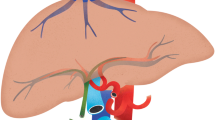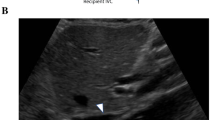Abstract
As the number of patients with liver transplants continues to increase, radiologists need to be aware of the normal post-operative appearance of the different liver transplants currently performed along with the wide variety of complications encountered. The complications commonly affect the biliar and vascular systems and can include anastomotic bile leakage and biliary stenosis along with stenosis or obstruction of the hepatic artery, portal or hepatic veins and IVC. Other complications include parenchymal abnormalities such as hepatic infarction, organ rejection, localized collections and post transplant lymphoproliferative disorder. This article reviews and illustrates the role of imaging for pediatric transplantation including the role of interventional radiology.




Similar content being viewed by others
References
Otte JB (2002) History of pediatric liver transplantation. Where are we coming from? Where do we stand? Pediatr Transplant 6(5):378–387
Ryckman FC, Bucuvalas JC et al (2008) Outcomes following liver transplantation. Semin Pediatr Surg 17(2):123–130
Westra SJ, Zaninovic AC et al (1993) Imaging in pediatric liver transplantation. Radiographics 13(5):1081–1099
Ametani F, Itoh K et al (2001) Spectrum of CT findings in pediatric patients after partial liver transplantation. Radiographics 21(1):53–63
Sahani D, D’Souza R et al (2004) Evaluation of living liver transplant donors: method for precise anatomic definition by using a dedicated contrast-enhanced MR imaging protocol. Radiographics 24(4):957–967
Chan SC, Fan ST (2008) Biliary complications in liver transplantation. Hepatol Int 2(4):399–404
Fulcher AS, Turner MA (1999) Orthotopic liver transplantation: evaluation with MR cholangiography. Radiology 211(3):715–722
Sheng R, Ramirez CB et al (1996) Biliary stones and sludge in liver transplant patients: a 13-year experience. Radiology 198(1):243–247
Uribe M, Hunter B et al (2009) Posttransplant lymphoproliferative disorder in pediatric liver transplantation. Transplant Proc 41(6):2679–2681
Caiado AH, Blasbalg R et al (2007) Complications of liver transplantation: multimodality imaging approach. Radiographics 27(5):1401–1417
Crossin JD, Muradali D et al (2003) US of liver transplants: normal and abnormal. Radiographics 23(5):1093–1114
Garcia-Criado A, Gilabert R et al (2009) Doppler ultrasound findings in the hepatic artery shortly after liver transplantation. AJR 193(1):128–135
Jones VS, McCall JL et al (2009) Reverse portal flow after liver transplantation-ominous or acceptable? Pediatr Transplant. doi:10.1111/j.1399-3046.2008.01121.x
Marder DM, DeMarino GB et al (1989) Liver transplant rejection: value of the resistive index in Doppler US of hepatic arteries. Radiology 173(1):127–129
Nolten A, Sproat IA (1996) Hepatic artery thrombosis after liver transplantation: temporal accuracy of diagnosis with duplex US and the syndrome of impending thrombosis. Radiology 198(2):553–559
Pandharipande PV, Lee VS et al (2001) Vascular and extravascular complications of liver transplantation: comprehensive evaluation with three-dimensional contrast-enhanced volumetric MR imaging and MR cholangiopancreatography. AJR 177(5):1101–1107
Richard HM 3rd, Silberzweig JE et al (2000) Hepatic arterial complications in liver transplant recipients treated with pretransplantation chemoembolization for hepatocellular carcinoma. Radiology 214(3):775–779
Rossi AR, Pozniak MA et al (1993) Upper inferior vena caval anastomotic stenosis in liver transplant recipients: Doppler US diagnosis. Radiology 187(2):387–389
Ueda M, Oike F et al (2008) Portal vein complications in pediatric living donor liver transplantation using left-side grafts. Am J Transplant 8(10):2097–2105
Zajko AB, Bron KM et al (1985) Angiography of liver transplantation patients. Radiology 157(2):305–311
Berrocal T, Parron M et al (2006) Pediatric liver transplantation: a pictorial essay of early and late complications. Radiographics 26(4):1187–1209
Borhani AA, Hosseinzadeh K et al (2009) Imaging of posttransplantation lymphoproliferative disorder after solid organ transplantation. Radiographics 29(4):981–1000, discussion 1000–1002
Dhillon MS, Rai JK et al (2007) Post-transplant lymphoproliferative disease in liver transplantation. Br J Radiol 80:337–346
Donnelly LF, Frush DP et al (1998) Lymphoproliferative disorders: CT findings in immunocompromised children. AJR 171(3):725–731
McCormack L, Hany TI et al (2006) How useful is PET/CT imaging in the management of post-transplant lymphoproliferative disease after liver transplantation? Am J Transplant 6(7):1731–1736
Scarsbrook AF, Warakaulle DR et al (2005) Post-transplantation lymphoproliferative disorder: the spectrum of imaging appearances. Clin Radiol 60(1):47–55
Wu L, Rappaport DC et al (2001) Lymphoproliferative disorders after liver transplantation: imaging features. Abdom Imaging 26(2):200–206
Bianchi E, Pascual M et al (2008) Clinical usefulness of FDG-PET/CT scan imaging in the management of posttransplant lymphoproliferative disease. Transplantation 85(5):707–712
Koch DG, Caplan M et al (2009) Pulmonary hypertension after liver transplantation: case presentation and review of the literature. Liver Transpl 15(4):407–412
Author information
Authors and Affiliations
Corresponding author
Additional information
Dr. Paul S. Babyn has indicated that he has no relevant financial relationships or potential conflicts of interest related to the material presented.
Rights and permissions
About this article
Cite this article
Babyn, P.S. Imaging of the transplant liver. Pediatr Radiol 40, 442–446 (2010). https://doi.org/10.1007/s00247-010-1545-6
Published:
Issue Date:
DOI: https://doi.org/10.1007/s00247-010-1545-6




